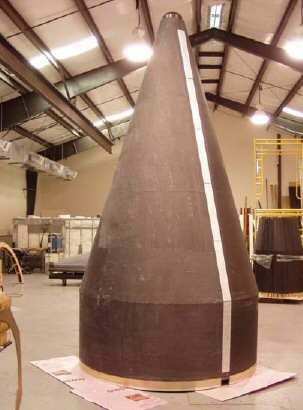Heaviest Single Load Record Comes After Longest Object Dropped
Last Year
A team comprised of AirLaunch LLC, DARPA and the US Air Force
made history this week, as a simulated AirLaunch QuickReach(TM)
rocket weighing 65,000 lbs was dropped out of a C-17A cargo
aircraft -- the heaviest single load to ever be dropped out of the
plane.

"This was an important step for the program," said DARPA's Dr.
Steven Walker. "It expanded the envelope of C-17 air drop
capabilities, and points the way toward a safe extraction technique
for an affordable and responsive spacelift capability."
The drop test was performed as part of the Falcon Small Launch
Vehicle (SLV) program, that is exploring a new way of launching
small satellites into space. The project is administered by the US
Defense Advanced Research Projects Agency (DARPA) and the US Air
Force.
"This test is another accomplishment that will lead us to the
next phase of the program and eventually to launch," said Debra
Facktor Lepore, president of AirLaunch LLC. "We are excited to be
working with DARPA and the Air Force to develop new technologies
that will enable operationally responsive access to space."

The drop test and related activities were conducted at
California's Edwards Air Force Base, by the Air Force Flight Test
Center (AFFTC) 412th Test Wing and the 418th Flight Test Squadron
in conjunction with the C-17 Systems Group of Wright Patterson Air
Force Base, OH.
The flight consisted of a 65,000 pound Drop Test Article (DTA),
which simulates the QuickReach(TM) launch vehicle dropped from an
unmodified C-17A aircraft at an altitude of 29,500 feet above Mean
Sea Level (MSL) and a true airspeed of 330 knots. The aircraft used
is on loan from Air Mobility Command to AFFTC.
"This drop test is the second in a series designed to assure
that we can safely extract the QuickReach(TM) rocket from a C-17,"
said Livingston Holder, AirLaunch's chief program executive. "With
each test, we get closer to the actual mission launch altitude and
launch vehicle weight, and ultimately developing a launch vehicle
that meets the Falcon SLV requirements."
The Falcon SLV program goal is to develop a vehicle that can
launch a 1,000 pound satellite to Low Earth Orbit (LEO) for less
than $5 million, within 24 hours of notice. It currently costs
about $20 million to launch a satellite of this size into space,
and the lead time can be months to years.
Having a quick reaction launch system that can launch
specialized small satellites will provide a new capability for both
military and civil applications as well as stimulate commercial
opportunities.
"The QuickReach rocket will enable the government to respond
quickly when a military need arises or in response to a natural
disaster by launching small remote sensing satellites on short
notice," said Holder.
AirLaunch's QuickReach rocket will carry small satellites into
LEO. These satellites can be equipped with communication, camera
and sensor payloads that allow special purpose support for military
activities, hurricanes, and forest fires, as well as enable
time-urgent communications in remote areas.

"Launching from the C-17 aircraft provides operational
flexibility that becomes extremely important in matters of national
security," said Lepore. "The data from this drop test will provide
us more information to develop this concept into a viable system
for the United States."
The team is in the second phase of the Falcon SLV contract or
Phase 2B. As part of this phase, AirLaunch recently accomplished
Milestone 3, which consisted of completed assembly of the payload
fairing and additional engine test firings of its QuickReach(TM)
stage two engine. AirLaunch previously conducted a stage separation
test and two engine test fires as part of Phase 2B Milestones 1 and
2.
In 2005, Team AirLaunch completed Phase 2A on time and within
budget with significant hardware development and testing. This
included four engine test firings, a stage separation test, a
ground drop test, and a C-17 drop test. At 65.8 feet, AirLaunch's
DTA was the longest single object ever dropped from a C-17
aircraft, conducted on September 29, 2005.
 ANN's Daily Aero-Linx (04.15.24)
ANN's Daily Aero-Linx (04.15.24) Classic Aero-TV: 'No Other Options' -- The Israeli Air Force's Danny Shapira
Classic Aero-TV: 'No Other Options' -- The Israeli Air Force's Danny Shapira Aero-News: Quote of the Day (04.15.24)
Aero-News: Quote of the Day (04.15.24) Airborne 04.16.24: RV Update, Affordable Flying Expo, Diamond Lil
Airborne 04.16.24: RV Update, Affordable Flying Expo, Diamond Lil ANN's Daily Aero-Term (04.16.24): Chart Supplement US
ANN's Daily Aero-Term (04.16.24): Chart Supplement US





